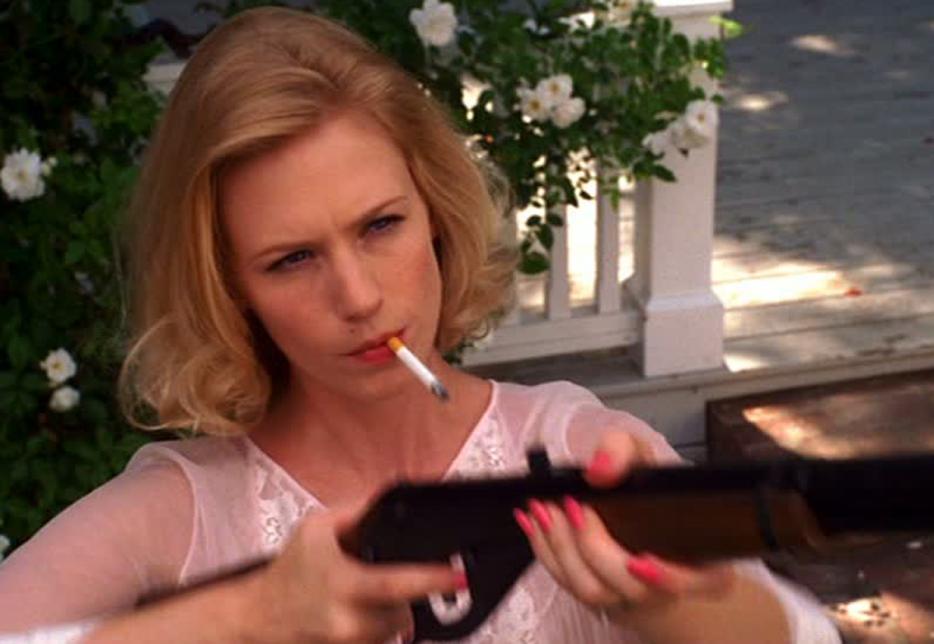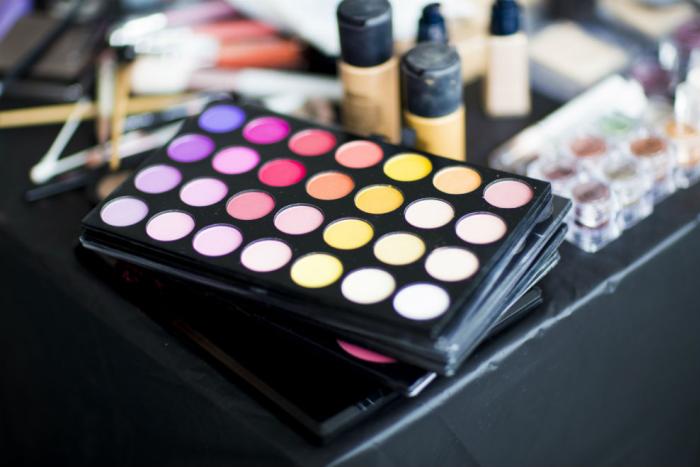Last year, I started to lose hours to online shopping. I’d scroll and click through everything, all stores, all styles, hoping for a whisper of guidance. I compulsively bought a blouse, sunglasses, too many jumpsuits.
I’d excitedly track their shipment, then let the clothes linger in their boxes and their bags, the fantasy of what they could be and could make me punctured against the reality of their arrival. More often I bought nothing. I simply imagined me in those clothes, preforming what it meant to be a woman, to be the most alluring version of myself. I craved that one item of clothing that would make me want less. That would make me.
I’d done this so many times before—this game of make-me-believe. It started when I was a tween, faced with the awkward prospect of buying a training bra at our suburban town’s newly opened Wal-Mart. With a tattooing heart, I defiantly reached for a three-pack of sports bras instead, deciding they would flatten, spandex me square. These high-cut bras were my subterfuge, a denial of a body I didn’t want. After that, I crafted a wardrobe of Adidas pants, XXL golf shirts, and anything else I thought could help me keep the me I wanted: a girl whose body remained a girl’s, straight and smooth as long grass.
Even after I grew accustomed to the idea of breasts, I remained gawky. My clothes turned black, destroyed and held back together with safety pins. My clothing was a cotton fortress. It lied for me: here is a teen girl who is tough and not afraid of her own body or yours, so back the fuck off.
In my early twenties, I turned once more, this time toward a budding professionalism: pencil skirts and low heels, uncomfortable slacks and blouses that modelled after a look I thought of as Adult Woman. The self-imposed rules of my latest un-chic configuration required I mostly opt for clothes I thought were both boring and sure to make me miserable. The way I dressed myself in those years was not an expression of my identity, but a uniform of the person I thought I should be: responsible, reliable, a projection of bland competence.
It couldn’t last. The sameness I saw in the mirror each morning wasn’t comforting, as I’d hoped it would become, but suffocating. I wanted something more. As Sheila Heti concludes in the introduction of Women in Clothes when pondering what a woman demands from her personal aesthetic: “I think she wants to be unique among women, a creature unlike any other.”
Clothing is an instant projection of who we are—or truer yet, who we want to be. For girls and women, especially, it tends to be how we’re categorized and assigned; how we’re minimized and fawned over; how those around us decide to ration their respect. Consider our years-long mania over Hillary Clinton’s suits, or the ink spilled in the U.K. over Theresa May’s shoes (a real late August 2016 headline in the Telegraph: “Theresa May reveals her shoes are the 'greatest love' of her life and that she dislikes her nose”). Consider the way we scoff at certain clothes on certain bodies, mutter “slut” and “trash.” Consider one of the modern myths women are plied with: that a Little Black Dress will make us perfect.
*
It started with a red dress. Then pink gingham with scalloped edging. Orange plaid button-down. There was a yellow wrap-around skirt with striped piping, a sailboat stitched at the corner. I’d bought it for my 29th birthday. My favourite was a green day dress with polka-dot pockets. Second favourite: a turquoise frock with roses, thrifted from a rundown Goodwill on Parliament Street in Toronto. Then there was the sentimental: My mother’s purple polyester with faded orchids and a broken strap, my first foray into the past. The assembly closed on a neutral note. A brown skirt from a second-hand store in Toronto’s west end. White, from small-town Ontario.
I don’t remember how I hop-scotched through the blogosphere to vintage fashion, but I do know why I loved it, immediately. Vintage clothing was so different from the clothes I’d bought before, those cardigans and wrap dresses draped on skinny mall mannequins, and yet it was effortlessly, beautifully composed—all things I wanted for myself. If my earlier wardrobes cycled through a deep yearning to hide myself, to fit in, to belong, then vintage clothing was what, I thought, would allow me to access the still deeper part of myself that wanted to stand out. As Heti writes: “The most compelling women are the ones who are distinctive, who are most like themselves and least like other women.” If I could figure out how to dress most like myself, perhaps it meant I could—finally—also figure out how to be the me I wanted: a compelling woman. The type of woman everybody still thought about after she left the room. Hushed in awe as they hid behind palms, complimenting her Look.
I collected vintage like a stamp fanatic, like an old man who idled over coins and war memorabilia—pursuits that have always struck me as masculine. I was obsessed. I hunted across the country, collecting vintage at Frenchys in New Brunswick, along Queen Street in Halifax, at a thrift shop in Drumheller, outside of Alberta’s Bad Lands. I even crossed the border, picking up a paisley house dress in Salem, an orange skirt with giant pockets at a pit stop on the way back to Toronto, the perfect pair of high-waisted shorts in Boston.
When I broke my leg so badly I couldn’t leave my bed for months, I cajoled my then husband into journeying out for me. He Facetimed me through the aisles of Value Village, pausing patiently at my direction, plucking out promising finds, rescuing them from a crush of shrunken T-shirts and sweaters gone lopsided. When he returned home, I greedily grabbed at the bags of musty clothes, inhaling the familiar, pungent perfume of used and discarded, imagined what new lives I’d give these lucky garments—and myself. I had clothes I never wore, but appreciated, a connoisseur of Peter Pan collars, wiggle skirts, novelty patterns. I’d take them out, admire them, then tenderly place them back inside The Closet.
Like a true collector, I always wanted more. My closet burst with colour, lace, pearls, sequins, full skirts, poofs upon poofs. I could squint and pretend my clothes were cupcakes, macarons, meringue—stacked sugar-laced sweets behind a patisserie glass. I dressed like candy and soda shops, episodes of Leave it To Beaver rendered into pastel Technicolor. I loved these old clothes for their possibilities. Wearing them was like slipping into the skin of another woman. One who was more glamorous than me, more sophisticated, definitively put-together and in control. I ushered this woman forward in time, then tried my best to become her—if I bought enough, learned enough. I spent hours watching YouTube tutorials and reading vintage blogs searching for inspiration. During this time, I perfected pin curls, winged eyeliner, a red lip. This woman I’d conjured was beautiful, something that was acutely important to me, even though I didn’t want it to be.
Whenever I opened my closet door during the years of my vintage obsession, I’d feel a rush. Each morning, I’d brush my fingers across the neat rows of fabric, delicate as a lover, thrumming with the anticipation of a first kiss. What would I be today? I owned so many clothes by then—all vintage or vintage reproduction, mostly from the 1950s and ’60s—that the closet’s rod bent under the weight of my feminine acquisitions. Colour-coded and hung together, they resembled a fat and drooping rainbow.
*
Then, in early 2015, my now ex-husband and I separated. Unable to afford my three-bedroom apartment on one salary, I had to downsize to a smaller space. There was no way I could take all my clothes with me. Unable to part with everything, I rented a storage locker and promised myself I could fill three suitcases and two wardrobe boxes—tall, unwieldy makeshift closets that still could not hold everything I owned. The rest I would donate. By the time I was done sorting everything into “keep” and “toss” piles, my bedroom floor looked liked melted cake, punctured soufflés, unicorn tears. When I later taped the boxes that would go into storage, my stomach panged with grief. I felt like I was at a funeral. I’d hollowed out my identity, the one I’d so tightly stitched to these mid-century clothes. In the first few weeks after I moved, I constantly reached into my shrunken closet for phantom items.
I’d deliberately, painstakingly crafted A Look. It was one that, I realize now, was perhaps less me and more a good mimic of a Stepford Wife. Once cleaved from me, I reflected on what it meant to dress like an old-fashioned housewife, a proper lady—always exact and constrained. Why did I like it so much? It was an uncomfortable line of inquisition. Part of me was defiant. Said to hell with it. It was my damn body, I could wear whatever I wanted. But I knew that was too easy. I wasn’t dressing passively. I wore vintage, at first, because I wanted that thing women aren’t supposed to want for themselves: to be seen. How much of it was really on my own terms? I worried it didn’t fit with my feminism, whether I could talk myself into believing it did, or whether it even mattered. Donning the clothes of women’s repressive past didn’t mean I supported it, or secretly yearned for it. If women could reclaim the word “bitch,” couldn’t we also reclaim pearl necklaces and lace gloves?
I mean, at least that’s what I told myself. I was newly self-conscious of my once perfect pompadour, my full petticoats, my swing shoes. I didn’t step inside a vintage shop for months. And yet, my wary avoidance solved nothing. I didn’t stop caring what I looked like more than almost anything else in the world. I didn’t suddenly slip back into my own skin, happy and satisfied and confident. Despite myself, I still wanted. Wanted to find that one perfect dress, perfect lipstick, perfect pair of shoes that would, a la Cinderella’s fairy godmother, stop the wanting and transform me into the best version of myself. The sparkly flawless version.
Clothes are an evolving expression of the selves we want the world to see—that’s what makes them so powerful. But, as women, it’s worth asking: who are we dressing for? Before I boxed my clothes and gave them up to cardboard tombs, I thought that answer was, finally, myself. Yet, left with the scraps of my carefully curated wardrobe I wasn’t so sure. Shrouded in my leftover, but flawless, cocoon coat, I still felt undressed, vulnerable. Still knew that I hadn’t yet achieved style—fed that naked, gluttonous wanting enough that I felt right when I stepped outside my apartment into the morning blush. Sated it so that I could leave the house and not think of myself as mirrors, a person or object in which others see themselves reflected. I wondered what a fullness like that would feel like. Speculated whether I could buy it.
*
Shortly after my separation, and the unfolding of my personal style, I stuck a Post-It note to my work computer, quoting Dress A Day blogger and author Erin McKean: “Prettiness is not a rent you pay for occupying a space marked ‘female.’” (It’s often misattributed to former Vogue editor Diana Vreeland.) Unmoored from The Closet, I wanted to remind myself that I didn’t need it—that I could move through the world free of charge, just as easily in a T-shirt as full circle skirt. McKean’s quote is from a longer blog post called “You Don’t Have to Be Pretty.” In addition to reminding women that they don’t owe attractiveness to anyone, she also wrote that it’s okay to be pretty, to want it as a quality for yourself. Less meme-ified is this second part: “You don’t owe UN-prettiness to feminism.” Beauty is not the most important thing, she adds, but it is “pleasant, and fun, and satisfying, and makes people smile, often even at you.”
I’m less rah-rah about that last part, mostly because I’m uncomfortable with how badly I want it to be true. Lodged within me, I contain twinning ouroboros of middle-finger feminism and the deep, unwelcome desire to have people smile at my appearance. I crave approval. I crave a feminism that tells me it’s okay to be this preoccupied by beauty. That can split this fixation down the lines of empowerment, like a seam, dividing it away from what I know to be true: that there’s a history here. I crave a clearer answer. A prescription that could cut through centuries of socialization and arbitrary beauty standards and a world that tells women the thing they should be most concerned with is their appearance. I don’t disagree with the obvious solution: that whatever a woman wants to wear is a feminist choice if she believes it is. But I struggle with how this works in practice. Even more so when I’m dressed like a Southern debutante or, perhaps, a layer cake.
Vintage clothing from my era of choice—the ’50s and ’60s—is undeniably pretty, even sexy. Yet, it is so in a way that’s almost always juxtaposed against, or derived from, its demureness, its lady-like nature, its idea of the era’s perfect woman. It’s all lines in the sand of who a woman can be. In its original context, this beautiful, constrictive clothing was designed as a specific, instructive way to perform femininity. It’s easy to forget such garments were intended to remind women of their functionality as human beings; to shoehorn them back into their homes; to return them to the binary roles of wife and mother. Unlike the factory work wear of the 1940s—clothes that echoed women’s first widespread independence—this tight apparel, with its rows of back buttons and its many suffocating layers, was intended to be put on with assistance. Its makers assumed women had people (well, men) around to help them dress. In fact, it demanded it. Knowing this, the heavy-lidded bedroom phrase “do me up” seems a lot less alluring.
Wearing vintage clothes in modern times attracts unsolicited, saccharine comments—ants to an ice cream puddle. In the years I wore it, I heard from men who wished more women dressed like ladies. From men who told me I looked high school student young, sweet, adorable. From men who commended my proclivity for dresses, praised my sartorial politeness. From men who asked to watch me try on clothes, who gave me their seats, who told me they remembered when. The whole vintage scene is saturated with “wholesome” vibes that reinforce the exact gender role divides I can’t stomach. In 2012, for instance, TLC aired a one-hour special called Wives with Beehives. It followed four twentysomething women around southern California as they integrated every aspect of mid-century living into their lives—from ancient work-out gear and incessant waist-minding to happy days spent baking, cleaning, and generally rejecting any career other than wife. (It’s worth mentioning that one of the main subjects later said that, while her love of vintage is real, much of the show was contrived, meant to make the women look ridiculous. “I was,” she wrote on her blog, “just a pawn in their game.”)
Actually, for the first time since the 1960s, the number of stay-at-home moms is on the rise. These yesteryear-idealizing women are far from alone. What’s just a nod to neat waistlines and kitsch houseware for some has turned into a cartoonish pursuit to return to a time where “Women were women, by golly!” for others. That this was a time before feminism existed is sometimes exactly the point. Some of the most influential homemakers, including one blogger I used to follow, who’s so busy these days she has staff writers, have mottos like, “I believe sweatpants are never the answer” and “You are the CEO of your household.” Many of these women love Jesus, love their husbands, love their babies. There’s nothing wrong with any of that—except that it all seems to come from a place of wanting to make ourselves, and our worlds, smaller, more palatable. It’s not a coincidence that finishing schools have made a resurgence. While men return to simpler times with axe-throwing, women get etiquette lessons.
I know not every woman who wears vintage has slid back into yes ma’am times. The vintage blogosphere is big and feminism is a controversial topic. Many vintage wearers wish the topic could be retired: it makes them feel good, so who cares what it used to symbolize? Feeling good about ourselves as women in an avalanche of media and marketing messaging that tells us not to, argue these women, can be subversive and empowering in itself. It’s a fair point. As Iris Marion Young writes in her essay “Women Recovering our Clothes:” “Patriarchal fashion folds create a meticulous paradigm of the woman well-dressed for the male gaze, then endows with guilt the pleasure we might derive for ourselves in these clothes.” She adds that, “Misogynist mythology gloats in its portrayal of women as frivolous body decorators.” In other words, we cannot win. We have to work on stepping outside the sewing box. To, as Young argues, recover our clothes. And in doing so, ourselves.
But how do you reclaim something that was never designed for our enjoyment in the first place? Another feminist scholar, Kaja Silverman, suggests we switch lenses: “Retro provides a means of salvaging images that have traditionally sustained female subjectivity, images that have been consigned to the wastebasket not only by fashion, but by ‘orthodox’ feminism.” She adds that vintage inserts the wearer into a “complex network of cultural and historical references” and that it’s the modern woman who gives the clothing its reference point. So, we subvert vintage by putting it on tattooed bodies, by stepping outside of capitalism and buying used, by taking hints of days past and proudly making patterns in bigger sizes than our 1950s or ’60s counterparts ever imagined. In a way, argues Silverman, it allows women to acknowledge that its “wearer’s identity has been shaped by decades of representational activity, and that no cultural project can ever ‘start from zero.’” If we look at vintage like this, it becomes a way to topple the male gaze—to actively wear our clothes with meaning.
I’m into all this, but hesitant. Hesitant because still so many vintage-clad women I know and see online embrace the back-in-the-day values. Certainly not all and maybe not even the majority, but enough to make the issue muddied. Hesitant because I don’t know why we all do it, dress like Mad Men, tsk at the women who don’t. Hesitant because, though I don’t want to admit it, I have my own tiny, mewling voices—kittens of protest. They remind me that while I wore only vintage for good reasons too—to dismiss modern beauty standards, to keep fast fashion out of landfills, and simply because I like it—my best, truest, most awful reasons were not progressive at all. These reasons knock around in my chest like mismatched buttons in a jar. That wanting. To be pretty. Not for myself, but for everyone around me. To be met with a smile that says, you look how a woman should. You are pretty. You have made it. There’s worth here.
I don’t want to discount how happy these clothes made me. I just mistrust all the other reasons I tell myself why.
*
I have no idea how to dress myself any more. I will readily tell you that I still wear the vintage items I have left. Last spring, I even bought an old denim jumper from the ’70s, shapeless and cool. More and more, I mix them with modern wear; less and less, I look like I stepped out of an old catalogue. I know, in so many ways, it’s not the clothes that are the problem, but the meanings I gave them. The way I idolized them. The way their makers wanted them to be idols, little gods of chiffon, cotton and lace. Prayers on bodies to make us so, everything right. This new mix-and-match is my own, small way of declaring ownership and intention over my clothes, my body, my appearance. But more than one year into my separation, I still hadn’t unpacked the boxes of my most prized vintage. I haven’t donated the rest either. They sat stacked for a year in my storage space, a visual and dusty reminder that I’m trying but have reached no satisfying answer.
One weekend, during the fading days of summer, I left my house in an outfit I’ve tried on in the safety of my bedroom many times, but have never before worn outside. It fits my new philosophy: thrifted, voluminous, high-wasted Kelly green shorts, a navy tanktop, silver sandals. It’s an outfit that rolls my back fat into dumplings, showcases the softness of my long legs, spotlights my too broad shoulders. It was a look that didn’t camouflage, didn’t apologize, did not embrace the word “good.” But for a moment, I felt amazing, the double exposure of who I am and who I want to be united. After that, I stopped shopping online as much. There have been no new versions of myself delivered to my mailbox. What I’ve really stopped doing is daydreaming myself into a better woman—if only I have those clogs, that Oxford shirt, that sparkly bodysuit. I unsubscribed from every newsletter that arrived in my inbox laden with sales, deals, new trends, promises. I’m reformed. I want to be. Like, I just want to be. I want to close reach into my closet, pull out something to wear that day and be happy. That is the new dream: that I will be me. And a dress will simply be a dress.






